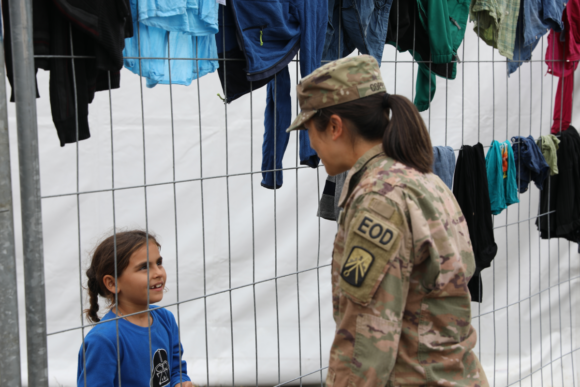Army grooming standards rarely change, so it’s a big deal when they do. Updates to Army Regulation (AR) 670, Wear and Appearance of Army Uniforms and Insignia, and the new ALARACT 40/2021, U.S. Army Appearance and Grooming Modifications, brought significant changes in 2021. In 2022, the Army updated its tattoo policy.
What Is the Purpose of AR 670-1?
AR 670-1 prescribes uniform and grooming standards for Army personnel. According to Paragraph 1-1, “The Army is a profession. A soldier’s appearance measures part of their professionalism.”
In other words, AR 670-1 exists to show soldiers how to look like soldiers. The standards outlined in AR 670-1 change over time to reflect changing views of what society considers appropriate and professional
What Are the New Army Grooming Standards?
The Army published its most recent version of AR 670-1 on Jan 26, 2021. In May 2021, the Army published ALARACT 040/2021, which contained further grooming standards changes.
According to the ALARACT, the next release of AR 670-1 will incorporate these changes.
Why Did AR 670-1 Change?
According to an information paper posted by Deputy Chief of Staff for Personnel Lt. Gen. Gary Brito’s office, the update is part of the Army’s efforts to promote diversity and inclusion.
Here is a summary of some of the recent changes:
- Removed the minimum hair length for males and females
- Allowed hairstyles include multiple hairstyles and ponytails for females and highlights for males and females
- Allowed earrings in all uniforms for females
- Allowed nail polish and lipstick for females
- Allowed clear nail polish for males
- Increased allowed religious accommodations, including for beards and mustaches
- Removed potentially offensive language to describe hairstyles and beards
Here’s more about the new changes and some things that have stayed the same.
Army Hair Regulations
The most significant changes are new regulations increasing the variety of acceptable hairstyles for female soldiers.
New Army Female Hair Regulations
The newest regulations give women greater freedom to choose hairstyles previously banned by the Army. Previous hair regulations disproportionately impacted soldiers with textured hair, including women of color.
Ponytails and Braids
The grooming standard changes make it easier and safer for women to secure natural hair of all types in garrison and combat headgear. Previous hairstyle regulations that required soldiers to wear long hair in a tight bun damaged soldiers’ hair and scalps. Buns also made wearing helmets and other tactical gear more challenging.
Women can now wear ponytails in every uniform. They can keep their hair in buns, single ponytails, single braids or two braids. They can also wear locs, twists and cornrows.
Women must wear braids and ponytails down the center of their backs. Braids and ponytails can not extend past the bottom of their shoulder blades when standing at attention.
The Army also repealed its ban on “multiple hairstyles” so women can combine cornrows, twists, braids and locs.
Short Authorized Hairstyles for Female Soldiers
In another change, the Army removed minimum hair lengths for women, which used to be ¼ inch. Women can also cut their hair in tapered styles (i.e., in a fashion that conforms to the shape of their heads).
Parts
Women can part their hair. If their hair does not part naturally, they can cut parts into it if they follow these criteria:
- Parts can’t exceed three millimeters in width (about 1/10 of an inch).
- Parts must be straight lines, not zigzag or other shapes.
- Hard parts must be cut into a natural part of the scalp (where a part would naturally occur).
No more than two inches of hair length can protrude from a soldier’s head in tactical and physical training environments. Buns can not exceed three and a half inches.
When wearing tactical equipment such as an advanced combat helmet (ACH), commanders may order soldiers to tuck their ponytails into their utility tops.
Highlights
Female soldiers can now wear highlights in their hair if the colors blend together naturally without a “vast difference” between the shades.
Highlights also can’t be unnatural colors, such as purple, blue, green, pink, bright red, fluorescent or neon.
Army Male Hair Regulations
Male soldiers can also wear highlights if they follow the standards listed above. The new grooming standards also allow them to shave their hair shorter than ¼ inch.
All other Army male hair regulations remain the same, including the following:
- Men must neatly groom their hair.
- Hair must have a tapered appearance.
- Hair can not be below the ears and eyebrows or touch the collar.
ALARACT 40/2021 removes offensive language previously used to describe hairstyles, including “Mohawk” and “dreadlock.”
Army Beard and Mustache Regulations
Though there has been recent talk of loosening beard policy, the Army has not yet revised its longstanding policies banning beards and restricting mustaches as of the latest round of updates.
Here are the current grooming requirements for mustaches and beards:
Mustaches
According to Paragraph 3-2 of AR 670-1, mustaches can not extend past the corners of the mouth (imagine a vertical line drawn upward from the corners of the mouth). Also, soldiers must keep mustaches below the lowest part of the nose.
Soldiers must trim their mustaches above the upper lip line and keep them tapered and tidy. Additionally, regulations prohibit a “chopped off” or “bushy” appearance.
Religious Accommodations
Soldiers may request religious accommodations to wear beards, turbans and hijabs, according to AR 670-1. Paragraph 5-6 of AR 600-20, the Army Command Policy, covers submission requests for religious accommodation.
Soldiers with approved religious accommodations for beards must follow the guidelines in Paragraph 3-16 of AR 670-1. Religious beards must be shorter than two inches, or soldiers must roll or tie them to under two inches to comply with regulations.
Soldiers with religious accommodations can grow their mustaches to connect with their beards, but they must trim or groom mustaches to keep them above upper lip lines. In addition, soldiers can not shape their facial hair into goatees, handlebar mustaches or other styles.
Medical Exemptions
A soldier’s medical exemption to the Army’s beard policy must specify the maximum length of the beard. Soldiers can not use medical exemptions to grow shaped beard styles like goatees and handlebar mustaches.
Army Piercing and Tattoo Regulations
Army women can now wear studded earrings in the Army combat uniform (ACU) unless in a field or tactical environment.
ALARACT 40/2021 restricts earrings to gold, silver or clear diamond. While in service or dress uniforms, female soldiers can also wear pearl earrings.
Earrings can’t be larger than six millimeters or ¼ inch in diameter. They must be “plain” and either round or square. Regulations prohibit hoop and drop earrings.
Women can wear only one earring per earlobe, and they must match. They can not wear earrings on other parts of the ear while in uniform or on duty.
Other Piercing Regulations
These existing policies on piercings remain in effect:
- Men can’t wear earrings while on duty or in uniform.
- Regulations forbid earrings that support “ear gauging,” which the Army defines as creating earlobe holes greater than 1.6 millimeters (1/16 of an inch).
- No restrictions apply to the type of earrings male and female soldiers can wear when off duty and not in uniform.
Tattoo Regulations
Tattoo regulations apply to both male and female soldiers. In 2015, the Army updated its tattoo policies to open the ranks to the 41% of millennials with at least one tattoo.
Here’s the current tattoo and brand policy:
- The Army bans extremist, indecent, racist and sexist tattoos no matter where they are on the body.
- Regulations restrict tattoos on the head, face, neck and hands below the wrist. Here’s what is allowed, according to a June 2022 memo signed by Secretary of the Army Christine Wormuth.
- Women can have conservative permanent makeup-like eyeliner and eyebrow liner.
- Men and women can have one tattoo that is less than an inch in diameter on each hand, as well as one ring tattooed on each hand.
- Soldiers may wear unlimited tattoos between their fingers as long as they remain unseen when their fingers are closed.
- Soldiers may have one tattoo on the back of your neck, provided it is less than two inches in diameter.
Soldiers with a previously approved tattoo memos do not violate current policy.
Army Religious Garments Regulations
Here’s a summary of the rules for religious garments while in uniform:
- Soldiers can wear religious jewelry but must conform to the standards for non-religious jewelry.
- Religious bracelets must be similar to ID bracelets in size, appearance and color (black or silver).
- Soldiers can wear any other religious items under their uniforms. The portion of any neck chain that appears outside of the collar must be no thicker than a standard ID chain.
- Soldiers can wear religious items in uniform during religious services, though commanders may restrict non-subdued items in a field environment.
- Religious head coverings must be in conservative colors (black, brown, green, dark blue), and standard military headgear must be able to cover it.
Hijabs
Soldiers can wear hijabs when they have an approved religious accommodation request. The hijab must be subdued in color or ACU-compatible camouflage and present a neat appearance. Soldiers must wear hijabs under any required headgear, and they must tuck the bottom of the hijab in the uniform top.
In a field or tactical environment, commanders may require hijabs to be fire-resistant.
Turbans and Under-Turbans
Soldiers with an approved religious accommodation request can wear turbans and under-turbans. Here is a summary of how they should wear them:
- Turbans must be in a similar color as the worn uniform. For instance, when in ACUs (formerly called the OCP), turbans should be of a matching camouflage color and pattern. In units with special headgear – like maroon, tan or green berets – commanders may require that turbans match these colors.
- When worn, turbans replace other military headgear.
- Turbans should display rank in approximately the same place as standard headgear.
- Hair under turbans does not have to follow AR 670-1 regulations, but it must not touch the ears or uniform collar or fall below the eyebrows.
Other Religious Uniform Standards
Soldiers with religious accommodations can wear long-sleeved Army physical fitness uniform (APFU) tops and subdued leggings under APFU shorts. The material of the leggings may not contain logos, patterns or be otherwise obtrusive.
Army Eyeglasses, Sunglasses and Contact Lenses Regulations
There are no changes to policies regarding eyewear. Here are the current regulations:
- Eyeglasses must be conservative in design and can not be trendy or have initials or designs that stand out.
- Soldiers may not wear sunglasses indoors unless required by a medical authority.
- Sunglass lenses can only be brown, gray or dark green.
- Soldiers can not affix chains or ribbons to eyewear except for restraints when required for safety purposes.
- Contact lenses can not be tinted to change eye color or shape, but medical authorities may prescribe opaque lenses for specific medical conditions.
Army Jewelry Regulations
Soldiers can only wear the following visible jewelry:
- Wristwatches
- Religious bracelets
- ID bracelets
- One item per wrist, except for pedometers, activity trackers or heart-rate monitors, which soldiers can wear with a watch or bracelet on the same wrist
- Two rings (a wedding-ring set is considered one ring)
- Conservative tie tack or clasp (men)
- Earrings, as described above (women)
- Pens and pencils of any color in uniform slots prescribed for that purpose
The following restrictions apply to jewelry, even when not visible:
- Men and women can’t wear piercings anywhere but their earlobes, on- or off-duty.
- Dental ornamentation is not allowed, including gold caps and platinum caps.
Army Nail Regulations
According to ALARACT 40/2021, female soldiers can now wear “solid color shades of nail polish that are not extreme.”
Here is what’s allowed under the new nail regulations:
- Nude or natural nail polish
- American manicure (a nail design with contrasting neutral tips)
- Light pink
- Maximum nail length of ¼ inch from the tip of the finger
Here are some things that are not allowed:
- Extreme nail shapes, including ballerina, stiletto, arrow and coffin
- Extreme colors, such as purple; white; yellow; gold; hot, bright or fluorescent/neon colors
- Ombre or extreme two-toned colors
- French manicure (a nail design with a contrasting white tip)
For the first time, men can wear clear nail polish. They must still trim their nails so they do not extend beyond their fingertips.
Army Makeup Regulations
Unless medically prescribed, men still can not wear makeup.
These makeup policies apply to female soldiers:
- Women can wear makeup in all uniforms.
- Makeup should be modest and conservative.
- Women can’t wear eyelash extensions without a medical prescription.
- Lipstick can not distinctly contrast with lip color.
Breastfeeding Women
With the latest 670-1 update, the Army explicitly allows breastfeeding women to do the following:
- Wear an optional T-shirt designed for that purpose (also applies if pumping)
- Unzip or remove ACU coat or other dress/service uniform jackets when actively breastfeeding
- Unbutton shirts when breastfeeding
- Breastfeed anywhere where mother and child are authorized to be
- Not cover themselves or their child when breastfeeding
Who Does AR 670-1 Apply To?
To borrow a phrase from basic training, AR 670-1 applies to “Ladee, dadee, everybody.”
Specifically, it applies to the following:
- Regular Army
- Army National Guard
- Army civilians
- Veterans
- Reserve Officer Training Corps
- West Point Cadets
AR 670-1 does not apply to chiefs of staff, who can decide their own uniforms.
Does AR 670-1 Apply to Retirees?
Yes! AR 670-1 applies to retirees when they wear their Army uniforms.
Paragraph 22-3 of AR 670-1 describes occasions when retirees can wear uniforms:
- Ceremonial events including funerals, memorial services and weddings
- Parades on national or state holidays
- Other patriotic parades
- Ceremonies in which regular Army or reserve units participate
The regulations restrict ceremonial attire to service and dress uniforms only.
Retirees can wear only APFUs combined with civilian clothes outside of Army installations.
If wearing the APFU as a complete uniform, retirees must abide by the standards of AR 670-1, but they can add approved retired shoulder-sleeve insignia and identification badges.
Retirees can wear medals on civilian clothing, affixed in approximately the same place as on their uniforms.
Non-Retired Former Soldiers and Uniforms
Veterans with wartime service who were honorably discharged can also wear uniforms, according to Paragraph 23-4 of AR 670-1.
Those with honorable wartime service can wear their uniforms on ceremonious occasions, like those described for retirees, but they must follow AR 670-1. They can not wear ACUs or APFUs for these occasions.
Regulations entitle former soldiers who served honorably in wartime to wear medals in the same manner described above for retirees.




About the comments on this site:
These responses are not provided or commissioned by the bank advertiser. Responses have not been reviewed, approved or otherwise endorsed by the bank advertiser. It is not the bank advertiser’s responsibility to ensure all posts and/or questions are answered.